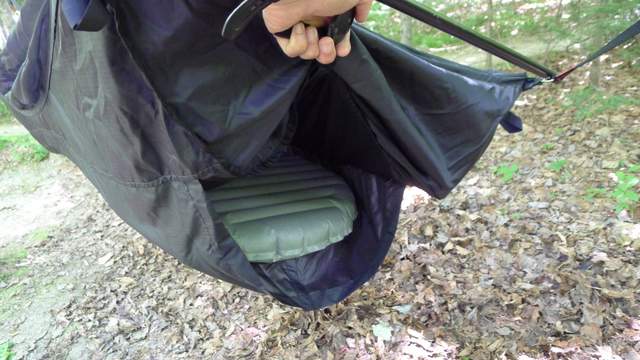Staying warm in a hammock in cool weather can be a challenge. While everyone’s metabolism is different, most people begin to feel cool in a hammock when the outside temperature reaches 65-70 degrees. At this point, the addition of bottom insulation is usually required to augment whatever sleeping bag or quilt you use to cover the top of your body in the hammock.
Sleeping Pads
While warmer clothing can help somewhat, one way to stay warm is to insulate the bottom of your hammock with a foam sleeping pad, an insulated inflatable sleeping pad, or an insulated quilt that hangs on the outside of your hammock. Lying on top of insulation inside a hammock, for example, on top of a sleeping bag, doesn’t provide significant insulation for your back and butt because your body weight compresses it, eliminating its ability to retain hot air.
Some hammocks, called double hammocks, have an inner compartment (slung under the fabric layer you lie on) that can hold a foam or inflatable sleeping pad. The extra layer forms a pocket that holds the pad in place so it doesn’t shift underneath you at night. If you sweat or perspire during the night, the condensation will pass through the fabric next to you and collect on top of the pad instead. Some people also use Reflectix instead, a building insulation material that has plastic bubbles encased in reflective plastic, but it doesn’t have as high an R-value as a foam or inflatable pad.

If you have a single-layer hammock, you can also use a foam or inflatable pad inside it, but it’s less comfortable because the foam folds around you or tries to porpoise out of the hammock when you roll over (hilarious.)
In warm weather, I often use small foam torso-sized pad and put it under my butt to prevent COLD BUTT SYNDROME, or CBS as it’s known, which is when your butt gets cold at night in a hammock, usually around 4:00 am (it’s a function of when you last ate a meal.) I also use an inflatable NeoAir XLite NXT sleeping pad or a NeoAir XTherm NXT sleeping pad because they compress well inside my backpack.
Hammock UnderQuilts
When it gets much colder, below 45-50 degrees at night, many hammock campers switch to a down or synthetic hammock underquilt.
Hammock underquilts are hung from the long ends of a hammock and slung underneath, enveloping your back, butt, and the sides of the hammock and insulating them. They’re available in many temperature ratings. While they are considerably more expensive than a foam or inflatable sleeping pad, people like them because they’re lightweight and compress well in a backpack, and take up less space than other alternatives.
Underquilts are available in several lengths. I prefer a full-length quilt for colder weather, but some people use a 3/4-length quilt and put a small foam pad under their feet and calves because they sleep warm and don’t require as much insulation. This can save a little pack weight and expense. But it boils down to personal preference.
Warm Clothing
One way to increase your warmth and comfort in a hammock is to dress in warm clothing, perhaps warmer than you’re used to using in a sleeping bag to keep it clean. If you decide to sleep with a top quilt (more on this in a moment), it can help to wear a hat or balaclava over your head at night if you’re cold. Some people also invest in separate insulated hoods, like the Enlightened Equipment Torrid Hood, which is a good accessory for a top quilt and can also be used as a cold-weather hat. In addition to gloves and insulated booties, midweight or heavy-weight long underwear can significantly increase your warmth.

Top Insulation
Most hammock campers sleep with a quilt instead of a sleeping bag because it takes up less space and it’s a lot less frustrating to use in a confined space. That’s not to say that you can’t use a synthetic camping blanket, a wool or fleece blanket, or a sleeping bag. Those are all viable alternatives as long as they’re warm enough.
Quilts are a hoodless, lightweight alternative to sleeping bags, that are also available in many temperature ratings. Most have some sort of foot box and drape over you like a blanket. You can sleep on your back or your side with them and they’re easier to move when you need to get up to leave your hammock at night.
Wind Protection
Wind protection is increasingly important in cold weather and there are several ways to prevent it from stripping your heat away. The simplest is to lower your tarp to the ground or to get a tarp that has doors at the end to create a little cocoon for yourself.
You can also buy a hammock that has an over-cover on it that layers over-the-top netting to hold in your body heat like a tent. An over-cover can add another 5-10 degrees to your interior comfort, but you don’t need one unless you try to camp in freezing weather. Alternatively, you can also buy a separate winter sock that drapes over your hammock and achieves the same thing.
Closing Remarks
I hope I haven’t scared you off with this survey of the ways to sleep warm in a hammock. It’s fairly simple in warmer weather and only gets more complicated when things cool down. A blue foam pad or the accordion-style Therm-a-rest Zlite pad is more than adequate for moderate temperatures and an old sleeping bag works instead of a top quilt in a pinch.
One thing is certain, sleeping in a hammock is a very comfortable way to camp and it’s easy to get hooked once you try.
See also:
SectionHiker is reader-supported. We only make money if you purchase a product through our affiliate links. Help us continue to test and write unsponsored and independent gear reviews, beginner FAQs, and free hiking guides.
Updated 2024.
